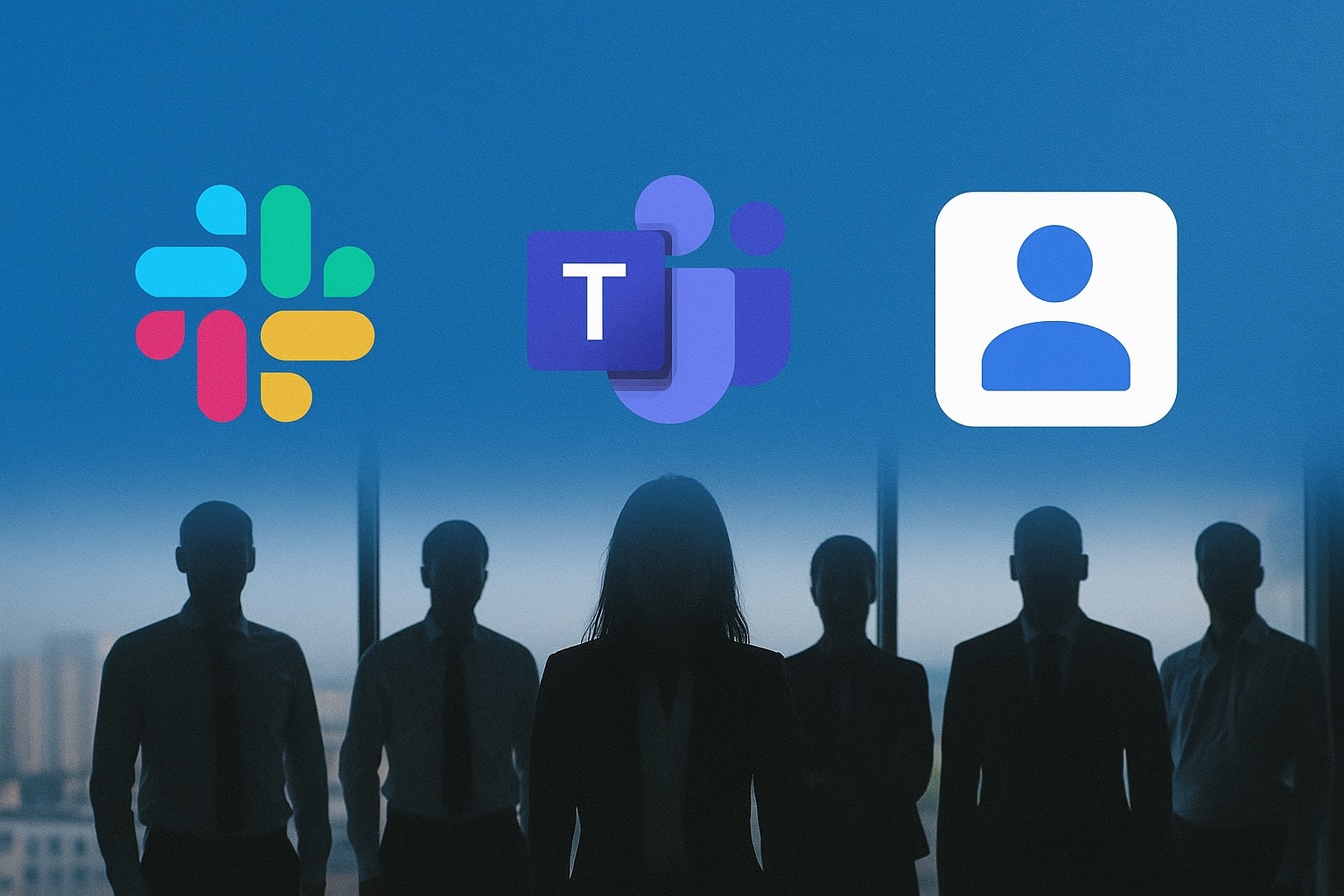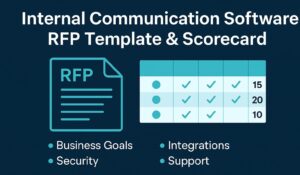When organizations evaluate employee communication platforms, the conversation often comes down to Slack vs Teams. Both are powerful collaboration tools, but they’re not always the best fit for every company—especially when budgets are tight or when engagement beyond messaging is a priority. Increasingly, companies are turning to all-in-one employee apps as a smarter alternative.
In this article, we’ll compare Slack, Teams, and all-in-one employee engagement platforms so IT, HR, and communications leaders can make an informed decision. We’ll also show how solutions like HubEngage combine top-down communications, bottom-up social engagement, recognitions, instant messaging, surveys, and even an AI chatbot into a single app—keeping adoption high and costs low. For a broader overview of tools, you can also explore our related resources on Team Communication Apps.
Why Companies Compare These Tools
Choosing the right communication platform is no longer about chat alone—it’s about engagement, productivity, and integration. According to a McKinsey report, improved communication can increase employee productivity by up to 25%. But with dozens of options, companies often ask:
- Do we need Slack or Teams, or something more comprehensive?
- Which tool delivers the best ROI for our size and needs?
- How do we balance collaboration with employee engagement?
That’s why the Slack vs Teams vs all-in-one employee apps comparison is one of the most common mid-funnel research journeys for IT and HR teams.
Slack Overview (Strengths, Weaknesses)
Slack is known as the pioneer of modern workplace chat.
Strengths:
- Simple, intuitive interface with strong adoption in startups and tech firms.
- Several app integrations, making it flexible for workflows.
- Great for quick, informal communication across teams.
Weaknesses:
- Costs add up quickly: the Pro plan starts at $8.75/user/month (as of 2025).
- Lacks built-in employee engagement features like surveys or recognition.
- Can become noisy, with message overload and poor searchability—one survey found 38% of Slack users reported information overload.
- For small businesses, Slack can feel like overkill when used just for chat.
Teams Overview (Strengths, Weaknesses)
Microsoft Teams has surged in adoption, largely thanks to bundling with Microsoft 365.
Strengths:
- Seamlessly integrated with Office apps like Outlook, SharePoint, and OneDrive.
- Strong video conferencing capabilities (Zoom alternative).
- Widely adopted by large enterprises according to Gartner.
Weaknesses:
- Steeper learning curve—many employees complain of too many clicks.
- Overloaded with features, leading to clutter and underutilization.
- Expensive for smaller organizations not already on Microsoft 365.
- Not designed for frontline or non-desk workers—Gartner notes Teams adoption is weaker among industries with deskless employees.
All-in-One Employee Apps Overview
This is where modern all-in-one employee apps shine. Instead of juggling multiple tools for communication, recognition, surveys, and engagement, companies can consolidate everything into one platform.
Key Benefits:
- Top-down comms: Leadership can share updates via push notifications, email, SMS, WhatsApp, and digital signage.
- Bottom-up engagement: Social features and recognitions empower employees to share, comment, and celebrate wins.
- Surveys & feedback: Built-in polls and pulse surveys gather real-time sentiment.
- AI assistant: Employees can ask questions and get instant answers via a chatbot.
- Cost savings: One subscription replaces Slack, Teams, recognition software, survey tools, and intranet add-ons.
📊 According to Gartner, companies using integrated employee engagement apps can save up to 30% on software costs compared to managing multiple point solutions.
Why HubEngage Stands Out:
Unlike Slack or Teams, HubEngage is designed not just for collaboration but for engagement. From instant messaging to recognition walls, AI-driven nudges, and gamification, HubEngage helps organizations achieve adoption rates that Slack and Teams often struggle with.
Feature Comparison: Slack vs Teams vs All-in-One Employee Apps
| Feature / Criteria | Slack | Teams | All-in-One Employee Apps (e.g., HubEngage) | Best For |
|---|---|---|---|---|
| Core Communication | Real-time chat | Chat + video conferencing | Multi-channel (chat, push, SMS, email, WhatsApp, signage) | Hybrid, deskless, blue-collar, and corporate employees |
| Integrations | 2,600+ apps | Microsoft 365 ecosystem | Pre-built + native engagement tools | Companies seeking consolidated platform |
| Engagement Tools | Limited (requires add-ons) | Limited (focused on MS stack) | Built-in recognition, surveys, social, AI chatbot | Companies prioritizing culture and feedback |
| Ease of Use | Simple, intuitive | Steeper learning curve | Mobile-first, gamified | Mixed workforce (frontline + office) |
| Pricing | ~$8.75/user/month | Bundled with MS 365 (adds cost) | Consolidated pricing replaces multiple tools | Cost-conscious SMBs and enterprises |
| Best Environment | Tech companies, Google users | Microsoft-centric enterprises | All companies (especially hybrid, deskless, and frontline-heavy workforces) | Companies balancing communication + engagement at scale |
Decision Criteria (Integration, Adoption, ROI)
When choosing between Slack, Teams, and an all-in-one alternative, consider:
- Integration Needs
- Slack integrates broadly, but requires add-ons.
- Teams integrates deeply into Microsoft ecosystems.
- All-in-one apps like HubEngage integrate but also include features natively.
- Employee Adoption
- Slack and Teams adoption drops with frontline workers or non-desk employees.
- All-in-one apps use mobile-first design and gamification to drive daily usage.
- ROI & Cost
- Slack: ~$8.75/user/month.
- Teams: Often bundled but requires full Microsoft 365 license.
- HubEngage: Replaces multiple tools, lowering TCO (Total Cost of Ownership).
Bottom line: For small to mid-sized businesses, Slack and Teams can feel like overbuilt and costly solutions, while an all-in-one app delivers more functionality at a fraction of the cost.
Conclusion
The Slack vs Teams debate is important—but it’s no longer the whole story. As organizations demand more than just messaging, all-in-one employee apps are redefining what “best employee app” really means. With HubEngage, you don’t just communicate—you engage, recognize, listen, and support employees in one mobile-first platform.
👉 Explore more in our guides on Team Communication Apps and Employee Communication Platforms.
🚀 Ready to see how HubEngage can unify your communications and boost engagement? Request a personalized demo today.
FAQs
Is Slack or Teams better for internal communication?
Slack is better for startups seeking simplicity and app integrations, while Teams is better for organizations already invested in Microsoft 365. Both tools, however, lack broader employee engagement features.
What is an all-in-one employee app?
It’s a platform that combines communication, social engagement, recognition, surveys, instant messaging, and AI chatbot support in one place. Unlike Slack or Teams, all-in-one apps reduce the need for multiple subscriptions.
How do you choose between Slack, Teams, and an alternative?
Evaluate your needs by integration, adoption, and ROI. If you’re focused only on chat, Slack or Teams may fit. But if you want higher engagement, feedback, and culture-building tools, an all-in-one employee app like HubEngage is the smarter choice.













